Colombia Against the Fossil Fuel Age
Colombia’s energy transition is not just playing out in policy papers — it’s unfolding in oil fields, coal towns, and courtrooms. Jacobin spoke with engineers, unionists, and President Petro himself about trying to realize a post-extractivist economy.

When Gustavo Petro won the presidential election in Colombia in 2022, he placed climate at the very top of his agenda — and he hasn’t deviated from that priority. (Luis Acosta / AFP via Getty Images)
Our taxi stops as close to the presidential palace as possible. We get out and join the queue. We hand our passports to the guards at the first check point. We then have to pass through several security stations, the gravity and solemnity rising with each. At long last, we are inside the halls, close to the innermost sanctum of state power, but we must wait for another hour or two until the time has come — now we also have to give away our phones — and the door to the office is opened and there he is: the president of Colombia.
He is reclining in his chair. Piles of books rise from his desk; one topped by Enzo Traverso’s Revolution. A keffiyeh is draped around a wooden bird. Bolivarian paraphernalia jostles with family photos, but above all, there is a chaos of books, and as soon as the polite greetings conclude, this head of state begins talking about the book he is himself writing: a Marxist analysis of the climate crisis.
During COVID, I started reading Capital for the third time in my life, through the lens of the climate crisis, because you can read it from many perspectives. I got sick with COVID, but I didn’t stop reading, I finished all three volumes and extracted the relevant material for my book. Climate change is just the atmospheric mirror of capital accumulation on Earth. The hurricane of accumulation produces a hurricane of energy flow. And this can lead to the end of humanity. There is an antagonistic contradiction between capital and life itself.
It is rare, to say the least, to hear a head of state speak in such terms. But then, Gustavo Petro is no ordinary president. He comes across as more of an eccentric professor, or a cadre activist unfolding an extended analysis of the world situation before his comrades. He springs up from his chair and grabs it from behind, then settles back into it for another long digression. He peppers his mini-lectures with references to Kohei Saito and Nicholas Georgescu-Roegen — hardly household names among policymakers in the year 2025. But more than anything, his idiosyncrasy is marked by one outstanding feature: he takes the climate crisis deadly seriously.
Right now, we are dealing with an outbreak of yellow fever in Colombia. It is directly caused by the rise in temperatures. This virus used to be limited to the lowlands, but when it becomes hotter it climbs to higher altitudes, to the coffee-producing areas, where forty people have died so far. Here in Bogotá, even though the city is surrounded by lush nature, we suffer from a shortage of water. If you look at the Amazon, it was entirely without water last year. Pink dolphins died in their hundreds in the river, their carcasses strewn on the banks. This is the alarm bell warning of the end. If the Amazon rainforest disappears, we reach a point of no return. COP30 will be held later this year in Belém — where the river meets the ocean, where nature is at its most amazing — and this really might be the last chance. Trump is not going to come, but all humanity needs to be there.
When Petro won the presidential election in 2022, he placed climate at the very top of his agenda — and he hasn’t deviated from that priority. If anything, his personal commitment to this one cause above all others seems only to have hardened. He has worked more assiduously than most to address the problem at its roots. Getting deforestation in the Amazon under control is, in his own account, a singular achievement. (One of his longest disquisitions during our time in his office concerns the nature of the hydrological cycle in the rainforest.)

But the progress is precarious. Deforestation rates still depend heavily on the power of narco-traffickers and armed gangs in the Amazon — forces his government has failed to rein in. Given the global distribution of emissions — deforestation accounting for about one tenth of carbon dioxide, fossil fuel combustion for the rest — perhaps Petro’s most extraordinary accomplishment might lie elsewhere.
When Petro was on the campaign trail in 2022, he pledged to wean Colombia off fossil fuel production. He would terminate the licensing of extraction projects. There would be no more new contracts for coal mining or drilling for oil and gas. There would be no fracking. Presidents and prime ministers who renege on their vows are legion, of course, but in this case, the election promises have been held to the letter: not a single permit for the extraction of fossil fuels has been issued under Petro’s guard. As he puts it: “Most important is to stop the export of oil and coal, even though they form 60 per cent of our export revenues. And the production of oil and coal is now falling rapidly. I told the country this is going to happen and we need to replace it with other things.” If there were more than one president like Petro, one might reasonably surmise, the world would look different from the way it does today.
“A Politics of Life”
Fossil fuels are not tangential to Colombia’s social formation. Oil and coal have long been the main tracks of capital accumulation running through its soil. Oil has been extracted here since the 1920s, coal since the 1980s; around the turn of the millennium, successive right-wing governments sought to outdo each other in accelerating the production of both. They singled out this particular industry as the “locomotive of growth.” They greased its wheels with licenses for every discernible deposit, opened up virgin terrain, and prepared for the next frontier: fracking — which, according to the energy minister in the cabinet before Petro’s, would triple the country’s oil and gas reserves. They behaved, in short, like every government in any major fossil-fuel-producing state. Before 2022, the Colombian state acted as expected by any committee for managing the affairs of the bourgeoisie: rushing fuel to the fire at maximum speed.
But the country was unusual in its extreme export orientation. The goal was not so much to consume fossil fuels as to sell them on the world market. The locomotive was headed north, where the oil and coal would be burned and — particularly in the latter case — the profits amassed. Coal seams were handed over to foreign companies for mining and transportation to faraway fireplaces. By the time Petro took over, Colombia exported more than nine-tenths of its coal — a share eclipsed only by Mozambique — and more than half of its oil.
It ranked sixth among the world’s coal exporters, unrivaled in Latin America; for oil, it placed twenty-fourth globally, third in the region. Fossil fuels accounted for more than half of the exports flowing out from Colombia and nearly half of all incoming investment. In biophysical terms — measured, for example, in tonnage — no other goods came close. Colombia has long exemplified ecologically unequal exchange: an archetypal periphery drained of resources by the affluent core — and fossil fuels have made up the bulk of the dissipated matter. At the same time, Colombia has developed an inordinate dependence on exported oil and coal for royalties, taxes, and other kinds of revenues. Other countries may have produced far larger quantities of either — say, the United States or China — without being so utterly at their mercy. Large, diversified economies would have an easier time shaking off these fuels.

Yet all of this changed in 2022 — or, rather, between 2018 and 2021, when popular fury at the neoliberal form of capitalist development exploded in one revolt after another, rolling out mass rallies and local assemblies, general strikes and communal kitchens, property destruction and pitched battles with the police across Colombia. It was this groundswell that crystalized in Petro’s election victory. The sequence of extraparliamentary struggle converted into electoral success matched an ideal type, which similar recent attempts in the North — notably the Bernie Sanders and Jeremy Corbyn projects — never reached.
Petro rode a wave of revulsion at the right that had ruled Colombia for two centuries. He made it a plank of his platform to strike at the base of the status quo: fossil fuel extractivism, by then widely detested. It had garnered a reputation as the locomotive of destruction of nature and people alike. Much of the brutal violence during the civil war’s later decades cleared land for oil fields and coal mines; capital streamed into lands emptied by massacres, only to devastate them further with pipelines and pits.
The climate crisis as such was probably not a preoccupation of voters. Yet Petro folded the extractive economy into the broader climate narrative, always linking the internal problems to the global predicament. He attached radical climate policies to the desire for a Colombia that doesn’t destroy itself. He framed it as a “a politics of life”: a rejection of self-destruction in favor of planetary and national survival. Once in the presidential palace, he launched what is arguably the world’s most advanced project for a transition away from fossil fuels. Consequently, it has come up against formidable obstacles.

Sunsetting Coal, Jump-Starting the Future
Coal is a vector of destruction in northern Colombia: fertile land turned into a lunar landscape of barren craters; water sources contaminated or vanished; air so thick with toxic particles as to make entire villages unlivable; extreme poverty entrenched around the mines. The gains from the “black stone” have been meager. Two foreign companies dominate the sector: Glencore, the world’s largest commodity trader and private coal exporter, and Drummond, a company from Alabama specializing in Colombian coal. Neither has welcomed the Petro government’s refusal to approve new mines. There is enough coal to keep production going for at least another century at pre-Petro rates — but the goal of this administration is to leave it in the ground.
Ironically, some market factors might here lend a helping hand. Colombian coal used to be exported primarily to Europe — notably the Netherlands — but demand on the continent is plummeting, while rising in Asia. However, ferrying millions of tons across oceans to Asian power plants requires long voyages. As the market tilts toward the East, the country’s coal is priced out: a company like Glencore will secure better profit margins by ramping up extraction in South Africa or Australia. For this reason, Colombian output has been falling from a peak of 100 million tons in 2017 to around 60 million last year.
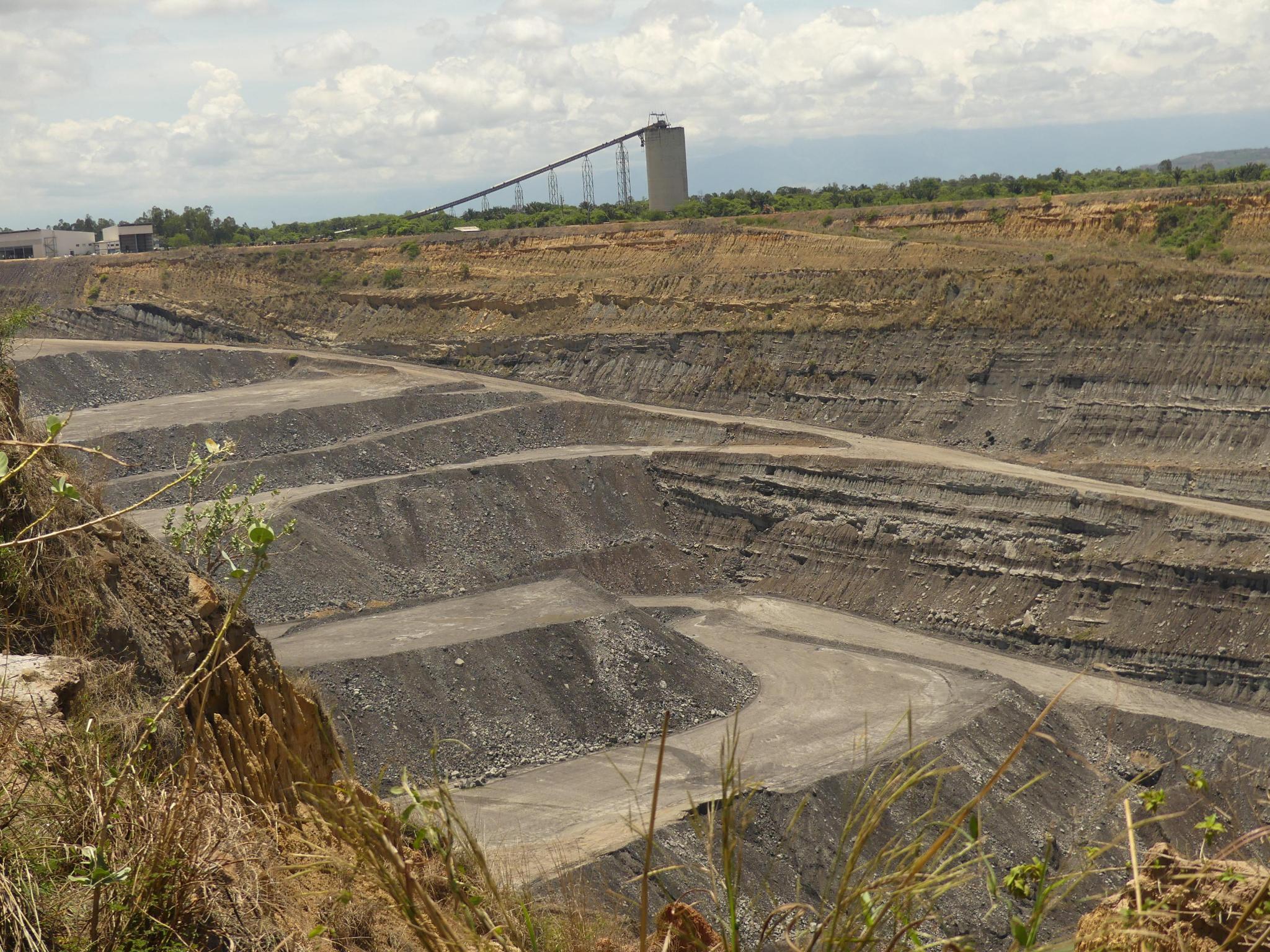
When we travel through the northern mining regions, Drummond has just announced an imminent halving of its production. “This is happening much faster than we expected,” says Felipe Corral-Montoya, an activist and critical scholar of coal who until recently served in the energy ministry. His opposition is anchored in a commitment to climate justice but bolstered by economic reasoning:
Our coal industry is on a trajectory of collapse. This ship is sinking. There is a time window of perhaps twelve to fifteen years, then it will be over. We were told that we were prophets of doom, but now even the companies admit that it doesn’t make sense to produce the coal here.
On a global scale, this amounts to a mere reshuffling of extraction sites — no gain for the climate — but paradoxically, it opens political space for transition advocates in Colombia.
There is already a fresh experience of unplanned collapse. In 2021, a subsidiary of Glencore suddenly closed its mines near La Loma in the province of Cesar, leaving eight thousand workers and their families high and dry. The result is a working population adrift and pollutants seeping into local streams. Trade unions have joined forces with rural and indigenous communities to hold the company responsible.
Meanwhile, there are worries about further closures to come: “We as coal workers are concerned because we have given our lives, our youth, our strength to these companies, and now Drummond is winding down. . . . They must leave us with something, some compensation when they go,” says Jenis Hernández, a member of Sintracarbón, the union of coal workers. For Corral-Montoya and other transition activists working with the Petro government, the argument is simple: plan and coordinate the inescapable end of coal — “better by design than by disaster.”
The mining industry and its friends on the Right do, however, have an objection: European demand for coal might well rebound. It did so in 2022, after the invasion of Ukraine. Donald Trump is doing his best to kindle a coal renaissance. More geopolitical turmoil is in store. And in one corner of Cesar, the concern is not about a chaotic withdrawal of the companies but a renewed incursion.
Cañaverales is a town wedged between verdant tropical forests and crystal blue springs. Visitors come to swim in its pristine waters. The two thousand residents identify as Afro-campesino and take pride in their self-managed irrigation canals and productive farmland — a regional breadbasket. “We are surrounded by water,” says Oscar Gómez, who sits on the board of the Community Council of the Blacks of Cañaverales. “We produce cotton, cassava, maize, and dairy products, but we know nothing about digging coal. With the stories I have been told, coal terrifies me.”
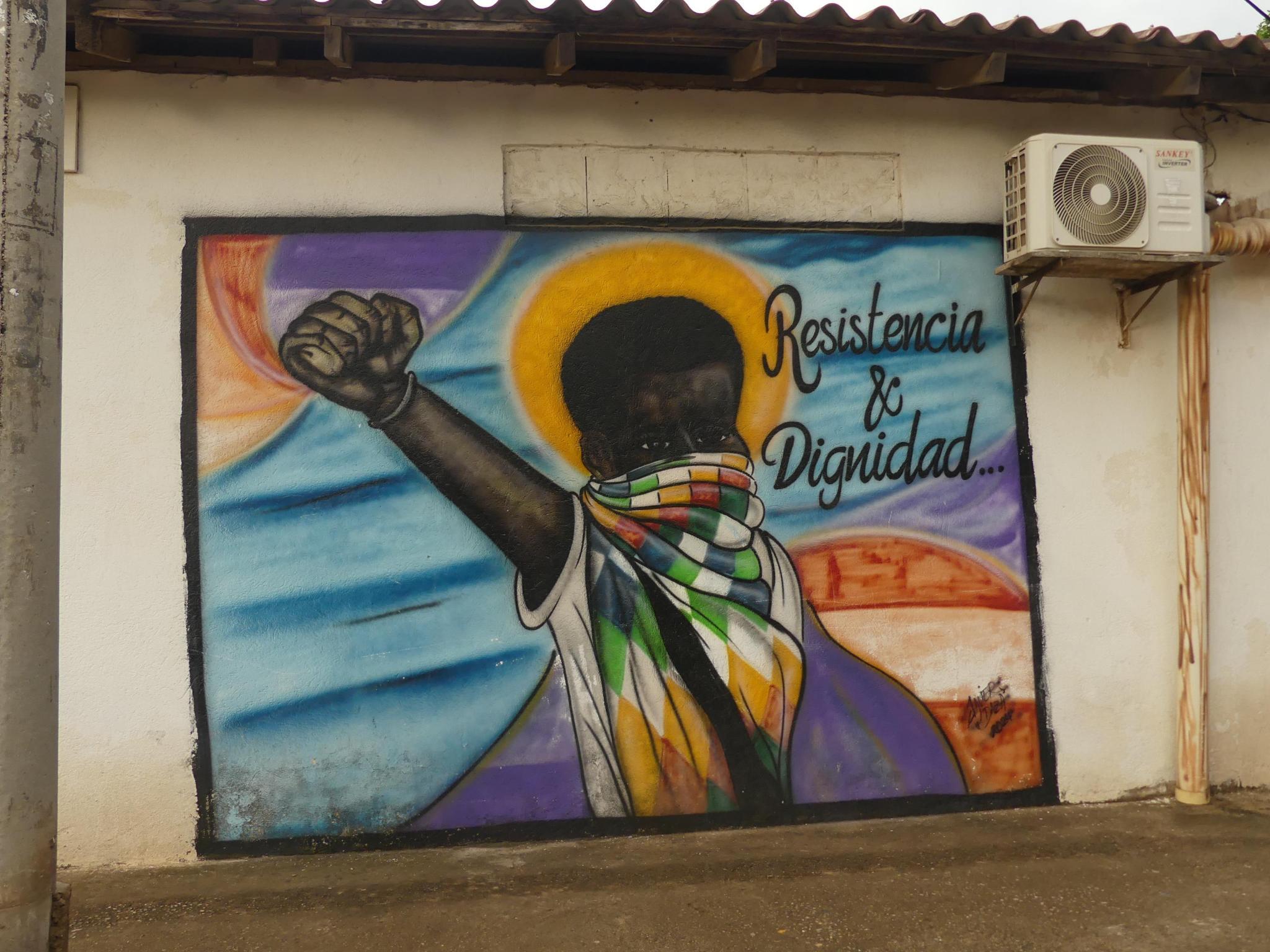
Seventeen years ago, a Brazilian company acquired a license to open a mine that would swallow most of the town’s land. As of 2025, the license is in the possession of a Turkish enterprise called Best Coal Company. Extraction has yet to begun, but residents fear that bulldozers could appear any day. Another member of the board, Geania Gómez Moscote, describes what is at stake:
In spite of the heat, we have a magical territory. We want to preserve it — the tranquility, the feeling of community; knowing that your neighbor can help you at any moment. There is a particularly crystalline spring in the forest that — for us — represents the heart of this land. But the heart is beating weakly now. The mine would destroy it. We don’t understand why this Turkish company wants to hurt us so much.
Why, then, does Petro not stop this mine project once and for all? Because the license is old, and the government won’t rip up contracts signed before it came into power. The Afro-campesinos of Cañaverales have fought a legal battle for years, supported by Rosa María Mateus from a lawyers’ collective in Bogotá. She is upset:
How can you allow a new mine to be opened, in the midst of this climate crisis, when the president has said there will be no more coal? The reason is the threat of a lawsuit from the company, within the frame of these perverse international treaties for investment protection. And so, we have to convince the government to exit them. Until that happens, go ahead, let them sue. In the end, it will be worth it to protect this ecosystem.
Right now, the state is turning a deaf ear to this community. The government is squeezed between international bodies and regional authorities that will let companies do what they want. Even Petro is not being listened to. It’s like a machinery that just runs on and on.
Preparations are now underway to escalate from legal to direct action, should the bulldozers show up. “We have to resist any onslaught,” says Hugué Martinez, also from the council board. “We are always told that the mining title was sold a long time ago, and so nothing can be done about it. But what if the contract is fundamentally flawed? We know that we are fighting a monster with a thousand heads, but we will continue, because for us it is a matter of life or death.”
The Inheritance of the State
The issue of preexisting contracts cuts to the heart of Marxist state theory and the contradictions of reformist socialism: an elected left will inherit an apparatus that is bourgeois through and through. It cannot simply “enter into full possession of the state, as if it were a new home: the rooms may be booby-trapped, the stairs barricaded; there may be snipers in the kitchen,” as Juan Carlos Monedero has put it. After electoral defeat, the class enemy can remain entrenched in ministries, in the judiciary, the police, opposition parties — and can deploy the media to whip up scandals and harass the cadres of change.

Few have experienced the contradictions of state power more acutely than Irene Veléz-Torres. She took over the ministry of energy in 2022. A charismatic young professor of geography, with an anarchist past and a later turn toward Marxism, she was inspired by Joan Martinez-Alier’s “environmentalism of the poor” and Paolo Freire’s “pedagogy of the oppressed.” Her research focused on the political ecology of extractivism and agribusiness in Colombia. It was she whom Petro appointed to seize the bastion of the fossil fuel industry within the state apparatus and execute the moratorium on licenses.
When I first arrived at the building of the ministry of energy, I walked the stairs up to the top of the pyramid — the sixth floor — to enter my office as minister. I found a room filled with insignias and logos and awards from all sorts of mining and hydrocarbon companies — Glencore, Shell, Occidental, small and big, everyone was there. It was like a temple for companies, like they had their eyes on me. This was a ministry meant to serve companies, not people. The first thing I did was to remove those signs, starting with the ones on my desk.
She initiated a dialogue with trade unions about how to organize the transition. “From one day to another, a ministry that was always going in one direction turned the opposite way, to the left.” Irene Veléz-Torres quickly became the bête noire of the Right, the most reviled member of Petro’s government. “I was the face of this policy, and it was just too much for the elites.” Vocal, eloquent, without a noble family lineage, she was an affront to bourgeois senses. When she had the temerity to suggest that rich countries — but not poor ones, like Colombia — should undergo “degrowth” and the Global South detach from “fossil capitalism,” she became the recipient of a torrent of abuse.
She was the subject of two impeachment attempts, endless X storms, and random physical attacks by enraged citizens — much of it shot through with sexist overtones: how dare this minister wear sneakers and such big earrings, and so on. After just one year, when threats extended to her children, she resigned. The energy ministry — formally, the Ministry of Mines and Energy — continued to pursue the phaseout of fossil fuels but without the magnetic leadership of Irene Veléz-Torres. She was brought down by well-placed shots from the bourgeois machine.
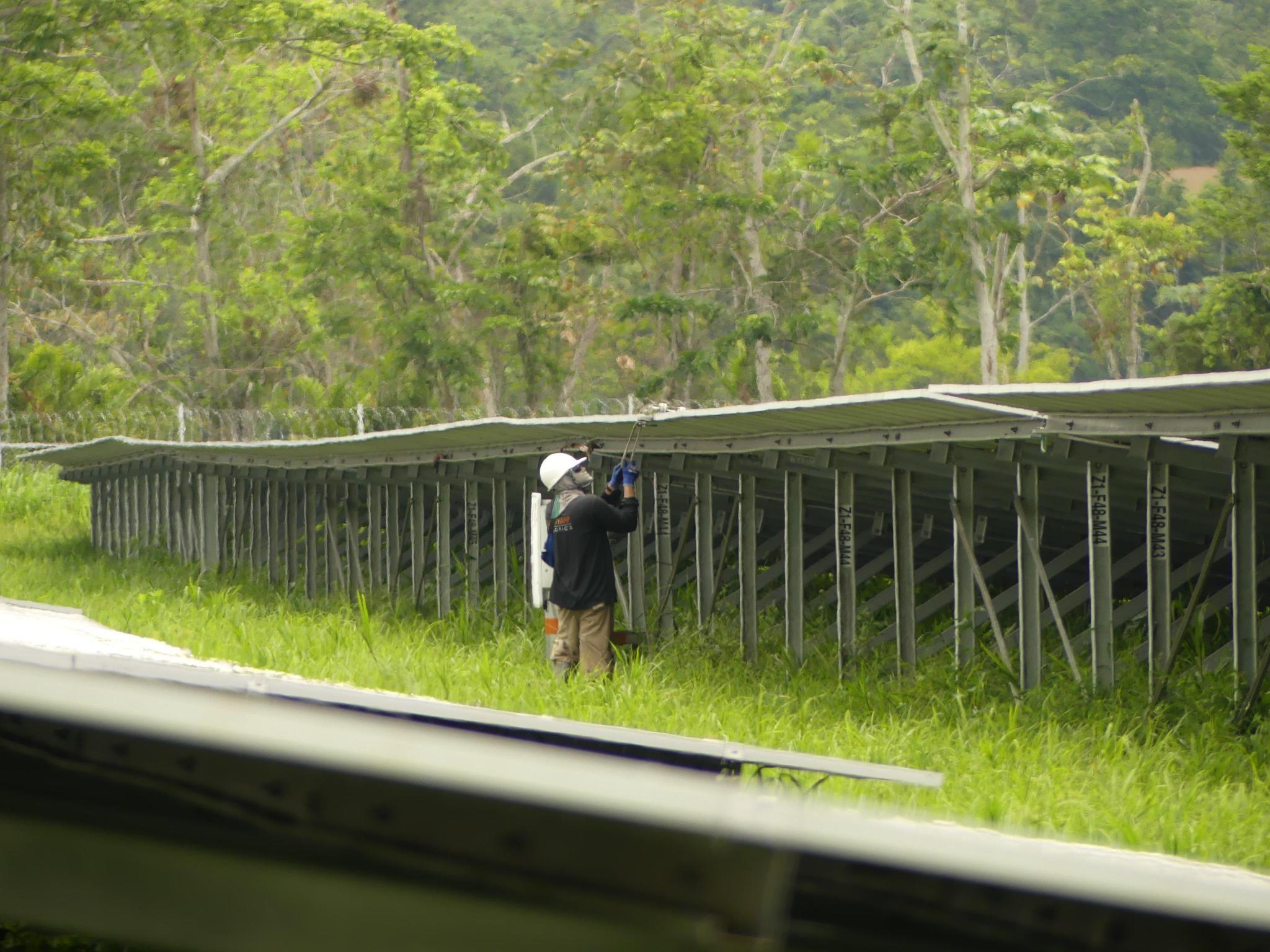
Two years later, however, in early August 2025, she was back: Petro appointed Veléz-Torres as his new minister of the environment. It was a sign of commitment to the transition and appreciation of his most controversial comrade-in-arms — and a signal that the last year of his presidency will see no scaling back of ambitions. The struggle to secure the power of the state is ongoing.
Cristo Petrolero’s Last Prayers
More important for the state than the black stone is the black gold. About two-thirds of Colombia’s oil is produced by a company still owned mostly by the state: Ecopetrol (the ecological-sounding name is purely accidental, the name an abbreviation of “Empresa Colombiana de Petroléo”). The end of coal would mean the end of profits for Glencore and Drummond. But the end of oil would deprive the state of a significant source of income — making the moratorium all the more daring.
An oil industry will hit rock bottom if reserves are not replenished. Continuous exploration is the sine qua non of a thriving petroleum business; without drilling, there will be no new fields to replace those depleted. The moratorium, in other words, is a death sentence. By several estimates, it will take effect by 2031: if the ban stays in place, Ecopetrol will have no more oil to pump by that year. Even a slightly more optimistic forecast suggests that the next decade will be its last. “Can Colombia’s Oil Industry Survive Petro’s Revolutionary Reforms?” read one glum headline in the business press. After he took office, drilling activity nosedived, contracts were suspended en masse, and Exxon departed the country, the expansion of this circuit of accumulation screeching to a halt. Total investment in oil production may have declined by 7 percent in 2024, and foreign direct investment in the sector by as much as 30 percent. A death spiral had been set in motion — by decree from the Left. “We face strong resistance in the financial system,” says Tatiana Roa Avendaño, vice minister of the environment, who spent many years as a grassroots activist and researcher before entering the cabinet. “But we did not get into government to manage the status quo. We did it, from a position in a deeply unequal balance of power, to open a crack in the fossil wall.”
It is difficult to exaggerate just how dramatically Colombia has here deviated from global trends. The year when Petro won, 2022, was also the year of an unprecedented profit bonanza in the global oil industry, prompting a frenzy of investment. Total spending on upstream production rose by 9 percent in 2023 and likely by another 7 percent the following year. That’s roughly equivalent to the decline in Colombia. Just as the rest of the world doubled down on fossil fuels, this nation started backing out of them.
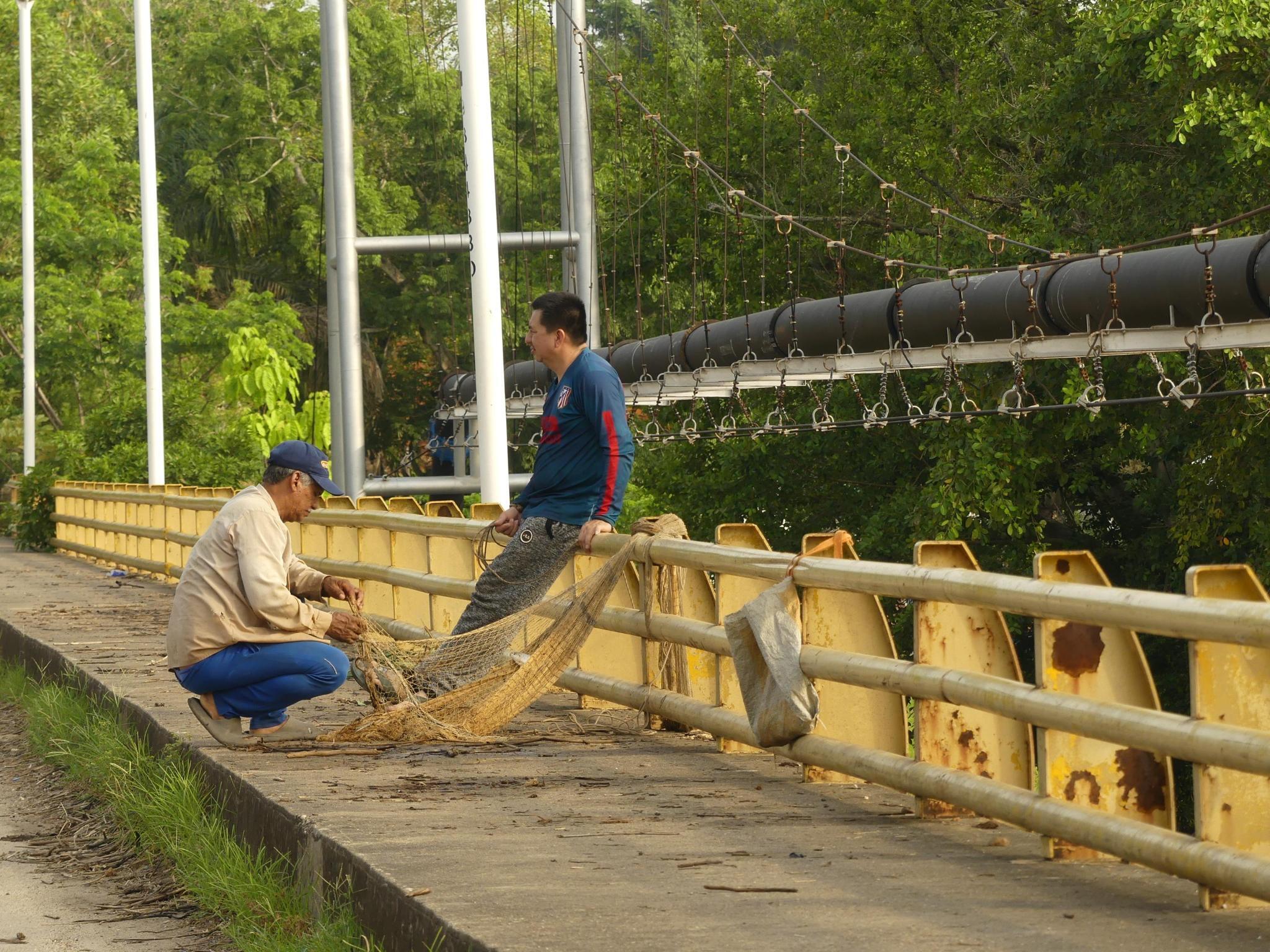
That does not mean, however, that all exploration has ceased. On the contrary, Petro and Veléz-Torres made it clear from the beginning that the more than three hundred existing licenses would be respected. More reformist than revolutionary, they sought a gradual strangulation of primitive fossil capital.
But that timeline may give it time to fight back. The entrenchment of oil in Colombian capitalism is nowhere more visible than in Barrancabermeja, the industry’s capital, an infamously hot and humid city on the shores of the Magdalena River. It is dominated by an enormous refinery complex. In front of it stands a wireframe monument of Jesus, stretching his hands toward the sky, known as “Cristo Petrolero.” Visitors mill in front of the Petroleum Christ and take selfies. In Barrancabermeja, employment, education, even religion revolves around the refinery and the rigs of Ecopetrol. Pipelines endlessly cross through the vegetation. Kids’ drawings on school walls depict oil installations and playgrounds feature wells.
But travel downriver, and you meet fisherfolk who have had their livelihoods laid to waste by the constant influx of contaminants. Yuli Velázquez is the president of Fedepesan, the regional fishers’ federation: she has documented the decline of species in the river and its tributaries for more than a decade. Endangered manatees have been found floating dead on the surface, alongside caymans, turtles, birds, and — most troubling for Fedepesan — thousands of fish. Velázquez takes us on a boat to show us oil spilling into wetlands next to an Ecopetrol pipeline. “There is a massacre of the fauna here,” she says. Fisherfolk say they suffer from ailments such as dermatitis and fungal infections. Velázquez would welcome an end to the oil industry; she fondly remembers how, during the COVID-19 shutdowns, the river returned as the refinery dialed down its activities. Across the country — from the Amazon in the south to the Pacific and Caribbean coasts in the north — ecosystems would indeed have a chance to survive if this industry were to expire.
But drive back into town, and most residents you meet will pray for Ecopetrol and other companies to stay. An intellectual hub of the industry is Universidad Industrial de Santander (UIS), the technical university of Barrancabermeja; Andres Mauricio Montes is the director of its campus. He wants oil production to continue for another century.
Oil is important, because we have a lot of people depending on it here. Colombia is not a country with specialized manufacturing or advanced technology — we export raw materials. We need access to our hydrocarbon resources, but the ban on exploration prevents us from finding them. It’s not convenient; it’s not the right way to do it.
UIS has a petroleum engineering program. It used to attract around five hundred applicants per year. After Petro came to power, that number fell to zero. Montes blames “bad propaganda from the government,” deterring “the boys” from the pursuit of oil. He is now working to convince students that petroleum has a future — citing carbon capture and storage that make it sustainable and facilitate enhanced oil recovery, already practiced by Ecopetrol.
Such a position is shared by the Right of the political spectrum. “They never tire of promoting the destruction of the mining and energy sector,” complained one congresswoman from Centro Democratico; former president Iván Duque, who stuck to a standard accelerationist approach while in office, denounced Petro’s policies as “social and economic suicide” (both comments came during the tenure of Irene Veléz-Torres, when rhetoric reached its highest pitch).
The pressure to revoke the moratorium has been immense. Adrian Correa — a Communist activist in his youth, now one of the cadres of the transition, until recently the director of a planning unit in the energy ministry — describes the narrative pumped out by the Right:
They say that stopping exploration will force us to import gasoline. We are risking our energy security — ‘Be ready, Colombians, you will soon run out of gas in your houses, you will not be able to cook, you will have to use woodstoves and go back to the Middle Ages.’ And unfortunately, they have been successful. It strikes a chord with ordinary people — this fear for survival.
The industry is organized into two business federations: Naturgas, for companies producing gas; the Association of Colombian Petroleum, for those producing oil – including BP, Shell, Petrobras, and other foreign giants. Both have funded think tanks and supported journalists and generously bankrolled a culture war against Petro and the Left.
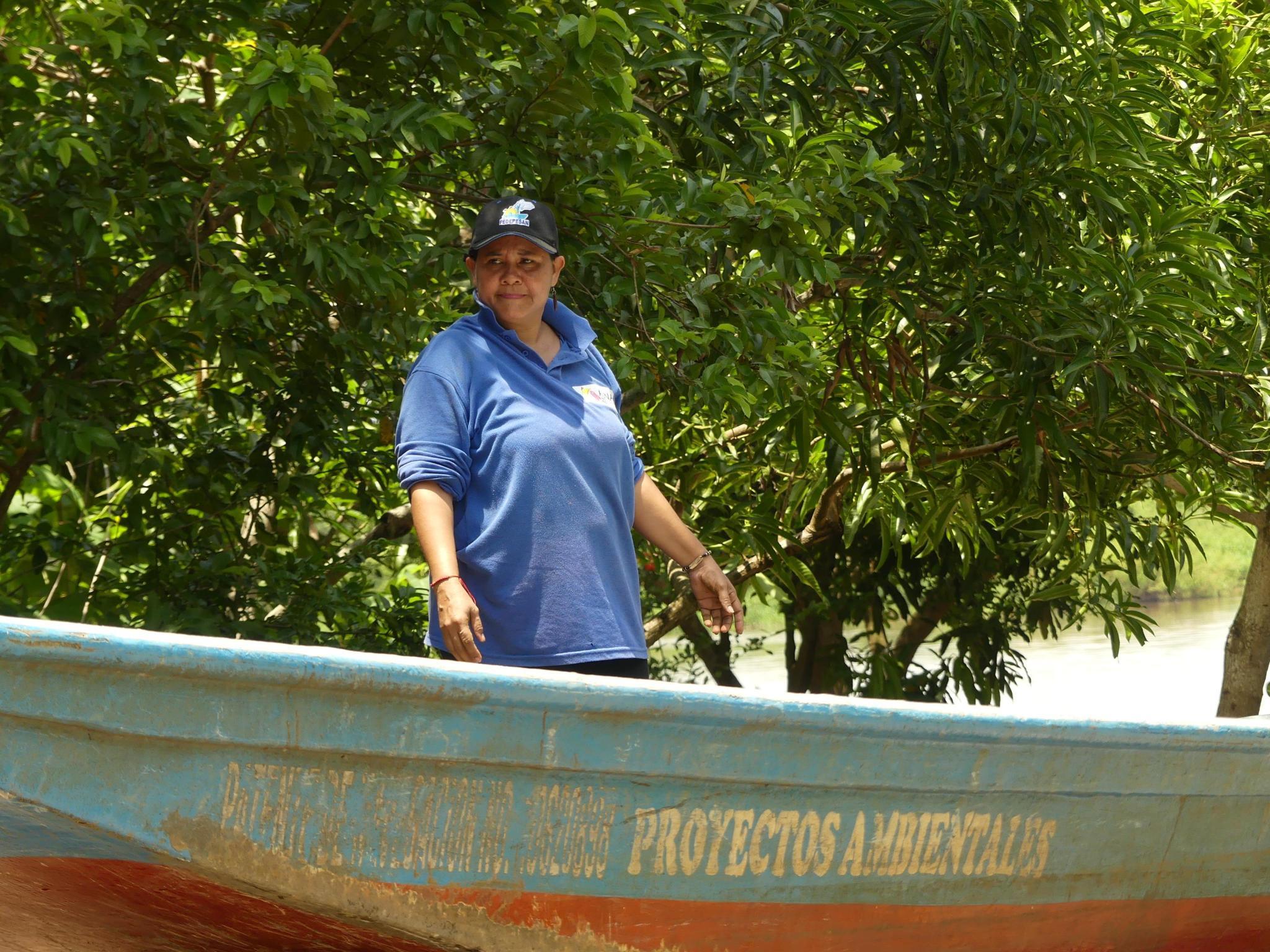
But Petro’s camp has countered with a strictly economic argument: the future of oil in Colombia is as bleak as coal’s. The crude is old, heavy, and expensive to extract. As soon as prices fall to $60 per barrel, profit margins are obliterated and fields shuttered. Even before Petro, production and export were declining. Colombian transition advocates argue that this country needs a safer foundation of development; it might as well give up on shaky oil and let others with more lucrative reserves continue.
The Right, of course, counters that oil prices could spike at any time — as they did in 2022. And Colombia, they insist, still has one humongous untapped resource: fracking.
The Right Loves the Smell of Fracking in the Morning
Ecopetrol as well as foreign companies — Exxon included — have long salivated over the reserves that could be unlocked if only fracking were given a green light. The greatest deposits lie in the area around Barrancabermeja, on the Magdalena River. An hour’s drive to the north is the Afro-Colombian village of Puerto Wilches. Here lives Yuvalis Morales, the young daughter of a fisherwoman, for several years leading campaigns against fracking: she saw “pilot projects” by Ecopetrol and Exxon approved by the previous government. A ferocious popular struggle was put up against them. The people of Puerto Wilches had particular reasons to resist:
Fracking would destroy the swamps and marshes we rely on for fish and freshwater. There is a lot of nationalist propaganda around Ecopetrol, as a state-owned company that can bring in revenues for us Colombians. Some people in this country will say, “Why not? Bring it on, let them do fracking.” But here in this region, the average person is against it. And not only those who depend on water resources for their work — even middle-class people want to be able to brush their teeth! So we have had broad support and managed to win all the political and legal and economic battles here in Puerto Wilches. And then this government came into power and called off the pilot projects. The machines were removed.
That decision was the reason Exxon exited Colombia.

All the more intense the frustration and ire, from both domestic and foreign companies at the idea that a government could put such gold off limits. Andrés Gómez, who previously worked as a petroleum engineer for both Ecopetrol and Halliburton, became fed up with the industry’s destruction. He decamped to join the popular resistance and now works as the Latin American coordinator for the Fossil Fuel Non-Proliferation Treaty Initiative. In yet another move aligning the state apparatus with the social movements, Colombia became the first fossil fuel–producing country to endorse this initiative — for treating fossil fuel reserves as akin to nuclear bombs — during the COP negotiations in late 2023. But Gómez frets over the lingering danger.
The only opportunity for Colombia to open up truly extensive reserves of light oil and gas sits in a shale formation along the Magdalena, known as La Luna. It might be the fourth largest of its kind in the Western hemisphere. The United States has the Permian Basin, Argentina the Vaca Muerte — in both, it’s “Drill, Baby, Drill,” courtesy of presidents of the far right — and Mexico the Burgos Basin. Only La Luna has remained untapped until this day:
If fracking were to begin here, there would be a new export boom. And it would ravage the region. During the 105 years that we have had an oil industry in this country, 25,000 wells have been drilled. According to the plans of Ecopetrol, 12,000 wells would be drilled for fracking in just ten years — half the previous total. This is because a well is depleted by this technology after only about three years; it can’t be used for eighty or ninety years as with some of the conventional fields, so you have to drill and drill and drill — as they have been doing in the United States. And Ecopetrol intends to spend at least 50 million liters of water on every single well.
Where will this water come from? From the Magdalena River, of course. And once the water has been injected into the ground, it comes back to the surface heavily polluted. We will have more environmental destruction in one decade than we have had in one century.
So far, Colombia’s resistance to fracking has been the most effective in the Western hemisphere, and the Petro government has sought to codify its gains in law. It has failed. Five times, a bill for prohibiting fracking was put before Congress; five times the parties of the Right blocked it. The Association of Colombian Petroleum spearheaded the obstruction. As a result, the pause on fracking remains just that, entirely contingent on the current government’s determination to withhold licenses. With another president in the palace, the floodgates to La Luna could be opened.

Powering the People’s Grid
What, then, is the alternative to fossil fuels in Colombia? Like most countries in the Global South, it has immense potential for generating power from solar and wind. At the smallest scale, this might mean putting up a photovoltaic panel (PV) on a rooftop. The Petro government has promoted the concept of “energy communities”: installing panels in poor, rural settlements unconnected to the grid, enabling them to become self-sufficient in electricity and boost their agriculture. This initiative has proved hugely popular. At least 300 energy communities have been established with support from the ministry, with another 1,000 under construction. Because a PV on a hut does not threaten any powerful interests, it is, in one sense, the lowest-hanging fruit of the transition; in another, its most utopian vision. As President Petro argues:
Oil and gas and coal must constantly be expanded, because they represent capital, fossil capital. But we are a country of the sun, and solar changes the geography of power. The greatest potentials are in the Caribbean zone, where indigenous people live. And the capacity for auto-generation is very high; we have done all we can to incentivize it. Every family can supply itself with the electricity it needs, rather than buying it from the market. The big multinationals extract wealth through differential rent, as described in the third volume of Capital, but solar power removes this element. Energy communities free themselves from the tyranny of company and price.
His minister of education, Daniel Rojas — another Marxist intellectual — elaborates on this vision. It is not, he says, one of “ecological war communism” but rather about
democratizing private property as much as possible. We are not trying to have a completely state-owned energy sector, but a decentralized structure where every household can fund and generate its own electricity and sell it to others, where every school, every community can meet its own needs.
Subaltern communities have been queueing up for the formation of energy communities. One of them is called Pondores. Located within easy reach of a police station on the plains of La Guajira — one of the two northern provinces pillaged by the coal industry — it is a clutter of barracks, erected in 2017 for former Revolutionary Armed Forces of Colombia (FARC) guerilla fighters. After signing the peace agreement, a brigade of combatants came down from the mountains and moved into this camp, awaiting a more permanent settlement. Eight years later, their life in limbo is finally nearing its end. In Pondores, these politically highly conscious veterans of the armed struggle have improvised and experimented with forms of communal living: a cooperative shop, a newspaper, an energy community.
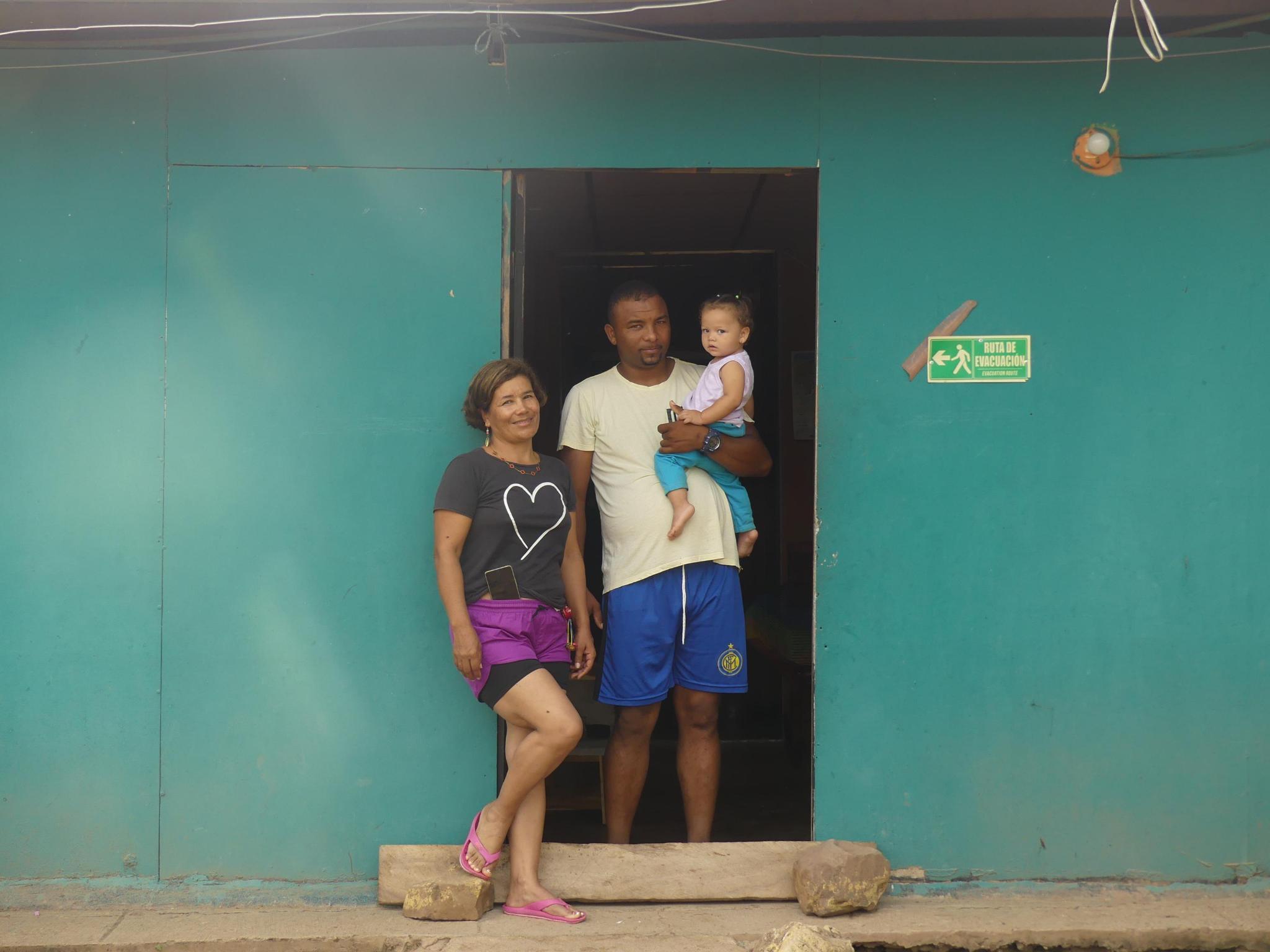
But they have not had a stable supply of energy, nor a steady source of subsistence. That is about to change. A stone’s throw away from Pondores, decent houses, agricultural plots and a solar park equipped with storage batteries is under construction — a new communal home for the ex-combatants, to be inaugurated before the end of 2025. Mary Luz, a demobilized fighter now forty-eight years old and a mother of two, is looking forward to the move:
I was with the guerillas for twenty-two years. It was nice to live in the mountains. We each carried our carpets and made our own little houses and lived well in the protection of the mother-forest. Down here on the plains, there is a lot of pollution from the coal mines — all the dust that gets into the air and makes you sick. But this solar project is an opportunity. It gives us autonomy, and it comes from the sun — not from other sources. There is too much heat these days, too much burning; we no longer know when it’s summer and when it’s winter. But we are grateful; maybe next year we can have a little house with more comfort and plant cassava and bananas. You have to survive on whatever you can find. That’s how you live.
In another corner of La Guajira, in the high, green hills of the Sierra Nevada, the indigenous people of the Kankuamo have likewise adopted solar power with zest. “The energy supplied by private companies here is very unstable,” explains Daniel Maestre Villazón. “It does not reach the required voltage to operate the equipment for our productive projects, our aquaculture, chicken farming, fruit pulping. This is why we want solar energy.” So far, only a handful of panels have been installed, but the hope is for more. “We want to create our own company to manage our own energy resources — we want to learn and develop and maintain this ourselves.”
An ethos of self-managed solar power has taken hold among some of the most disadvantaged communities in Petro’s Colombia. In only three years, the government has presided over an increase in solar-power capacity by a factor of ten. Such a build-out is not unique in itself, of course — but what is unique is its pairing with a shutdown of fossil fuels: a real transition, not just an energy addition.
Solar has been promoted far more consistently by this government than wind, despite strong coastal currents. Solar is cheaper. But wind will be required for a full transition, and a few turbines — remarkably few, from a European perspective — have been erected in La Guajira. Next to them live Luis Carlos Iguaran and his mother Maria Dolores, the traditional matriarchal authority of a Wayuu indigenous community. Long traumatized by the effects of the coal industry, they welcome the nearby wind farm. Solar panels have also been installed, bringing free Wi-Fi and basic services to the community. “This is good for us, good for the country, but too many projects are stalled and stopped.”

The rollout of wind power has been left to the private sector, and companies have pulled out of the region. One reason has been opposition from Wayuu people elsewhere, who have resisted the idea of yet another energy infrastructure on top of the hated coal. They cite unfair distribution of revenues, lack of consultation, and disregard for the spiritual significance of the landscape. As a result, the winds of La Guajira remain nearly as unexploited as the shales of La Luna.
The Market Hates the Sun
At the largest scale, solar and wind could replace oil and coal as export products. Petro has floated the idea of a transcontinental grid for renewable electricity, running all the way from Alaska in the north to Patagonia in the south. Colombia would feed its surpluses into the system and receive those of other countries in return. Two friendly governments — Uruguay and Panama — have recently bought into the wildly ambitious idea, the latter neighbor signing up for interconnection of high-voltage cables. Petro even took the proposal to Joe Biden. As he explained to us:
The hatred of Latin Americans in white society is so strong, they want to stop all immigration to the US. I suggested to Biden that we can do it by building this grid, generating economic development in our countries so people don’t have to migrate. He understood but did nothing. I haven’t been able to speak to Trump — I wrote him a letter but he did not respond. Trump is pure nationalism; he just wants to extract more oil and gas. He doesn’t even believe in climate change.
If this curious offer to keep the Latinos away from the United States were ever realized, it would probably never generate profits on the scale of oil and coal. A transcontinental grid of renewable abundance would push electricity prices toward zero. And therein lies a familiar, structural obstacle to the transitional program of Petro and his comrades: solar and wind cannot generate profits like fossil fuels.
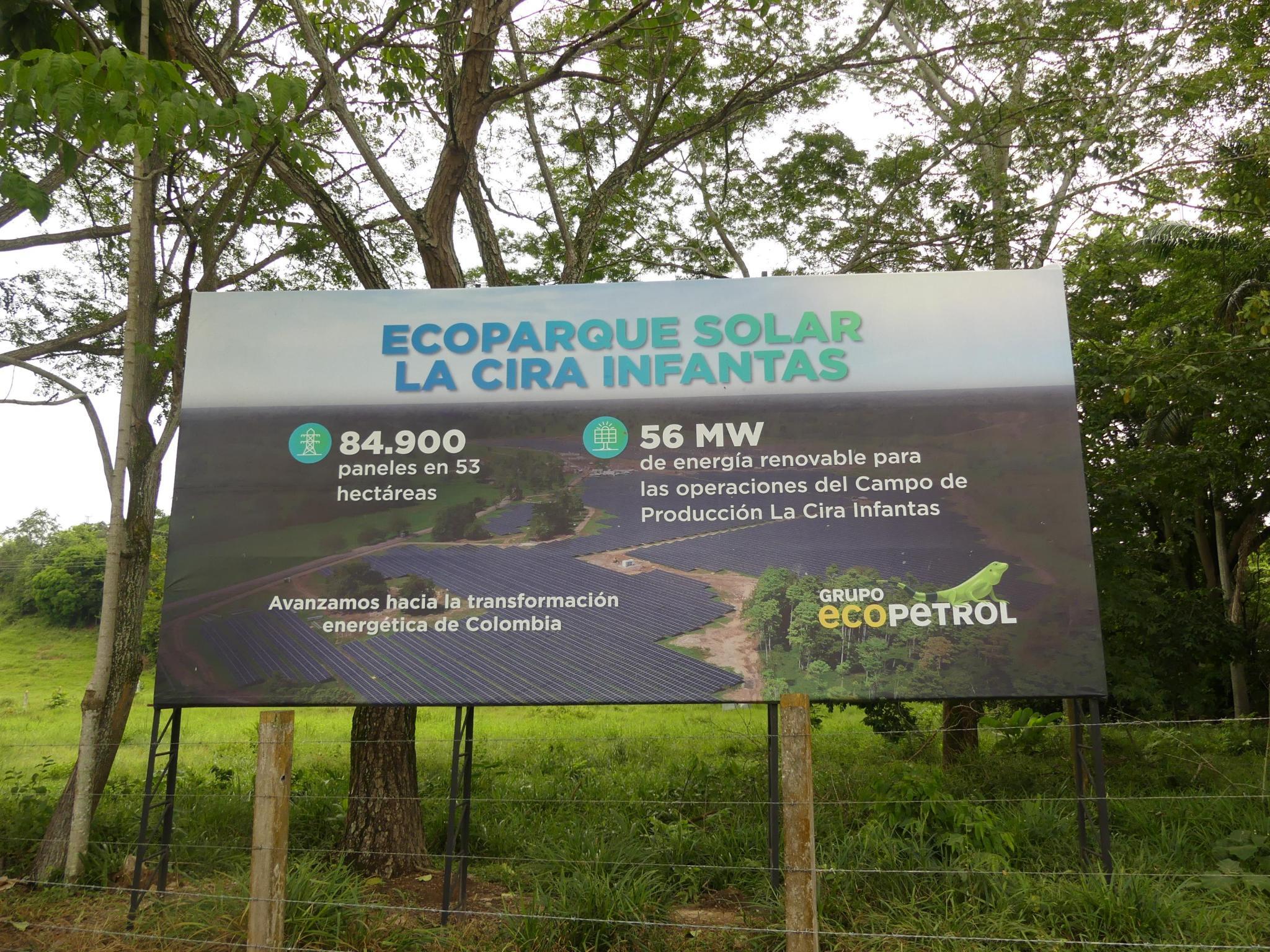
Ecopetrol knows this. Next to its oldest oil fields outside Barrancabermeja, known as La Cira Infanta, it has built the region’s largest park of solar panels — not to sell the electricity as a commodity (which would make no one rich) but to power the oil rigs as cheaply as possible. Ecopetrol is the single largest consumer of electricity in Colombia. It is expanding solar power capacity in order to raise profit margins in its core business: hydrocarbon extraction. Much of the electricity from the solar park is fed into a plant that injects tens of thousands of cubic meters of water per day into the ground to push out the remaining oil. Petro has not objected; in fact, he attended the inauguration of the park and signed one of the panels. (He has, however, objected to another source of Ecopetrol’s profit: its fracking operations in the Permian Basin. But when he tried to get the company to sell the assets, its stocks fell, and he backed off.) A considerable portion of Colombia’s current solar power generation is thereby used to prop up the profitability and prolong the life of its main oil company.
The unprofitability of solar and wind comes down to the absence of labor in their production. And for that very reason, some segments of labor have rallied on the side of fossil fuels. César Loza, the current president of the oil workers’ union, Unión Sindical Obrera de la Industria del Petróleo (USO), has pushed back against Petro’s policies: “The jobs generated by the oil and gas industry in Colombia are high quality jobs, thanks to the efforts of USO and its workers. By contrast, jobs generated by alternative energy sources, like solar energy, tend to offer low wages and don’t require as much labor.” No one digs sunlight or drills wind. Hence, he concludes, “we need further oil and gas exploration, no matter what.”
This could be seen as the position of a fossil labor aristocracy, defending its island of privileges in a sea of precarity and poverty — “privileges” here in a very relative sense. Oil still appears as an opportunity for a good life for people in Barrancabermeja and its surroundings. One Ecopetrol worker, who prefers to be anonymous, tells us how he found employment in the company at age nineteen:
I come from a poor family. I needed money. It was a miracle for me to be hired in this sector with no experience. I didn’t want to live in poverty and still don’t want to — I want to live well. I want my family, my children to live well, because I experienced a lot of need in my childhood. When I started at Ecopetrol, I saw that it was a way to earn good money. It is, let’s say, one of the best jobs in Colombia — it’s at the top, to be able to work in Ecopetrol; I earn six times more than the average person. And my bosses earn much more than a minister in the government.
Showing us around in La Cira Infanta, this man points out the company estates where workers live in buildings provided by Ecopetrol that are supplied with electricity from its generators. “There are big and nice houses here, with air conditioning.” But he is aware that not all people in the region reap the benefits. There are frequent demonstrations around Ecopetrol facilities — “It happens every second week or so, people put up blockades on the roads to ask Ecopetrol to invest more in the region and give them jobs.” This individual worker has now ended up in the solar park. He is one of the few retained for its operation and maintenance. Some two hundred workers were hired for the construction of the park, a mere thirty staying on site after its inauguration — a tiny fragment of the workforce engaged in actual extraction.
Similarly, a handful of the workers who lost their jobs when Glencore shut its mine at La Loma retrained as engineers skilled in installing solar panels. But once the panels are up, they are up; the sunlight comes for free, unlike coal. Inside La Loma, many working families would be happy to see the mine reopened, as it could provide jobs in numbers that solar seemingly cannot. The town is surrounded by three Drummond open-pit mines, on which the population depends for jobs and incomes. The privilege — if indeed that is the right term — of working in the mines has been carefully rationed by this company: only one member of each family can be hired. This structural dependency on fossil fuels, this magnetic pull into mines and fields as the best sources of a decent wage, would seem to predispose organized labor to defend extraction. And without labor firmly on its side, how could a government ever defeat fossil capital?
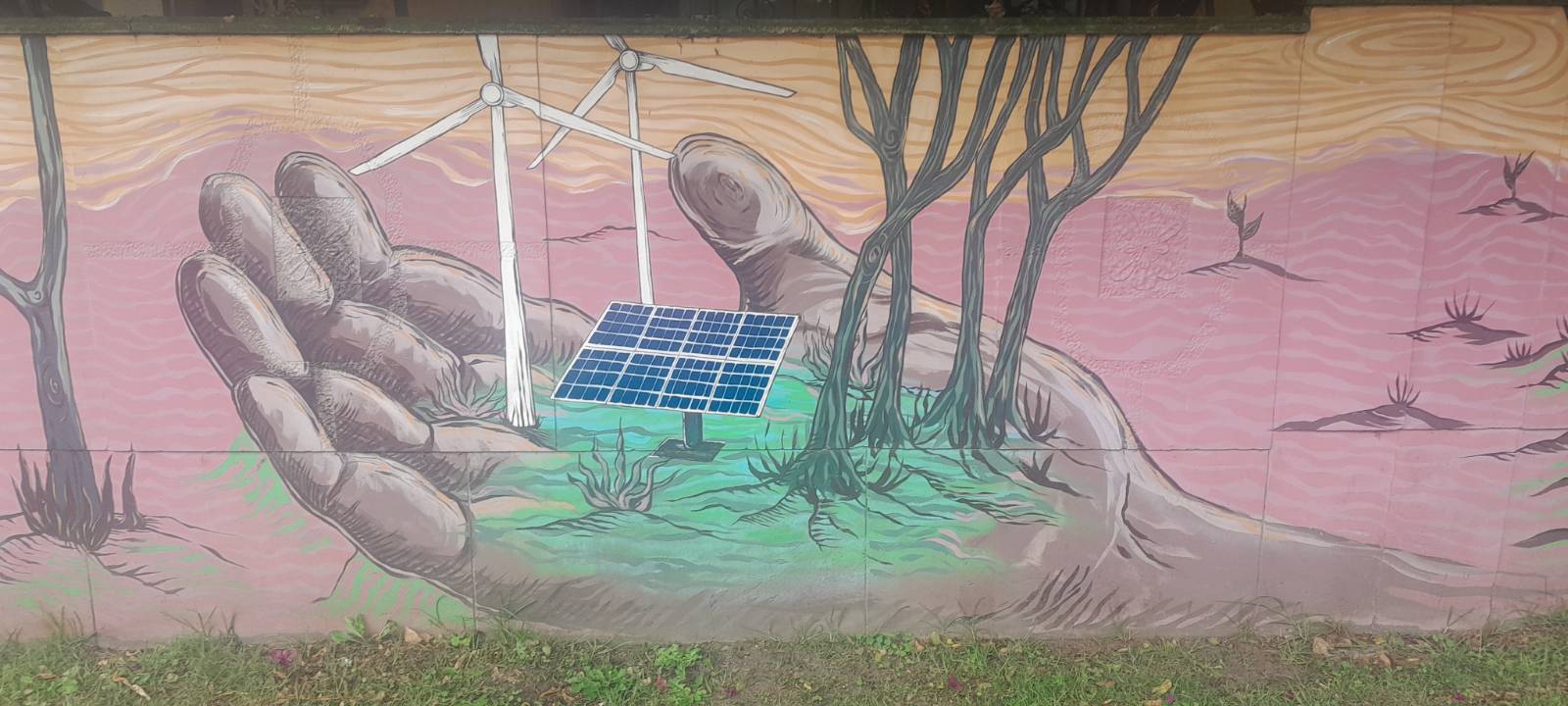
But in Colombia’s trade unions — highly politicized, after a century of militant agitation and rounds of civil war — more progressive currents run strong. The leadership of USO has not gone unchallenged in its support for fracking. A powerful opposition has aligned itself with Petro’s agenda. At the Aury Sará center in Bogotá, named after a USO leader martyred in 2001, a mural depicts an outstretched hand, out of which grows trees and solar panels and wind turbines. This branch of USO has just sponsored a seminar on ecofeminism. We speak to Juan Carlos Aguilar, a member of the USO national commission for the human rights of workers. Having worked at the refinery in Barrancabermeja for twenty-six years, he has no love lost for the oil business. “The energy transition is necessary, simply because we are exceeding the limits of balance in this world. Oil exploitation might have brought great wealth to some sectors of society, but it has also brought great poverty, violence and pollution, and none of this has been compensated for by the industry,” he says.
In recent months, the USO appears to have moved closer to Petro’s priorities. Edwin Palma, the current minister of energy — in a cabinet infamous for its high turnover — is a former leader of the union, who, in his new role, has accepted the official rejection of fracking. A series of energy communities is being planned for the region of Barrancabermeja, on whose oil fields he used to work. This development speaks, again, to the unique experiment in Colombia: the organization of oil workers is directly involved in the planning of a transition. But the capacity of renewables to replace all those jobs remains unclear. Juan Carlos Aguilar acknowledges that “there is still no real, material proposal from the government” about alternative sources of income for his colleagues. How can this nut be cracked?
Breaking the Resource Trap
One solution might be to rethink the energy transition as a break from the logic of resource dependency. In the eyes of Felipe Corral-Montoya and Catalina Combariza Diaz, who both work for the radical think tank Polen, the task is nothing less than to end Colombia’s status as an enclave of extractivism. “Anything short of a complete shift in the national economic model will only scratch the surface.” The notion that the future lies in the export of any energy or primary material at all would then be abandoned, the fortunes of the people delinked — in the classical sense – from that of the rich core. As Corral-Montoya explains:
We should use our abundant renewable energy resources to process and produce stuff here. We need to build local, internal linkages. Solar power could animate our food processing industry. When we roll out electrical buses here in Bogotá, we should also manufacture them. We were retrofitting my mother’s old car to be electric — and one can envision a general retrofitting of the Colombian car fleet in workshops around the country. And the components needed could be built in factories here.
We now have a project on the Caribbean coast for making motorbikes electrical, and they even work better than the old gasoline models because they have more torque. We should think of our renewables as a foundation for the industrialization of Colombia.
This would, the argument runs, rebut the right-wing fearmongering around “energy security”: rather than continuing to rely on gasoline, electrify everything and plug it into domestic systems.

It could also bring labor fully into the fold. Workers in the coal and oil sector could be offered skilled industrial employment. Corral-Montoya continues:
The thing with solar plants is that you don’t need so many workers after construction — just some for cleaning and maintaining and guarding. So workers cannot be shifted into electricity production as such, but they can go into electricity-intense industries. Everything else will be seen as a declassing. They will say “I don’t want to be farmer, I don’t want to be a freelancing entrepreneur installing solar panels — I have my status as a coal miner or oil worker.” And that’s why unions haven’t necessarily supported the transition, because so far it has mostly benefited the poorest people. They want other stable jobs with a high income. One could imagine them forming cooperatives that will be the industries of the future.
Corral-Montoya doesn’t see himself as an ecological John Maynard Keynes or Vladimir Lenin but an “ecological Raul Prebisch. The international division of labor between colonial and colonialized countries is, for me, the DNA of our situation.” From this perspective, the one-sided dependence on export of fossil fuels is not a reason to desist from a phase-out. It is, rather, its economic raison d’être.
Catalina Combariza Diaz takes a similar view and has applied this homegrown eco-structuralism to the case of hydrogen. Unlike solar or wind, green hydrogen can be exported as a commodity to any destination on the world market. Germany is a likely customer. Both the previous and the present government have invested hopes in this scenario. But why reproduce the constant drainage and leakage of resources out from this nation? Better to keep the green hydrogen at home and use it to produce cement and steel — both in urgent need of decarbonization — under the control of state-owned enterprises. Even domestic aviation, on which Colombia has become excessively dependent, could be fed with hydrogen-based fuels. Or the country could begin manufacturing trains with renewable electricity. The refinery in Barrancabermeja could become a green hydrogen hub and so on — there is no limit to the Colombian imagination.
In this context, the specter of a new mining boom for critical minerals inevitably arises. Will Colombia mark its ground with a new generation of ugly scars? Corral-Montoya, Combariza Diaz, Petro, and many others do not oppose extraction as such — materials will be needed to develop an independent, fossil-free Colombia — but they do reject extractivism: the model of churning out unprocessed goods for disposal elsewhere. And luckily, perhaps, Colombia does not have the lithium and copper mountains of Bolivia or Chile. But as with coal in Cañaverales, copper is advancing into some frontiers in the Amazon and Antioquia and, predictably, provoking similar resistance from indigenous and peasant communities, fearing that they will once again be victims of dispossession and destruction, but now in the name of “transition”. Petro personally opposes the mines in both regions. These battles remain unresolved, as powerful interests — foreign and domestic — strain at the leash.
Other ideas have been tabled in an anti-colonial vein. Advanced capitalist countries like Germany could give Colombia fiscal space for phasing out oil by writing off some of its debt. But as always, when rich countries are asked to pay, this idea has not sat well with them. In 2024, Petro’s government unveiled a plan for public mega-investment in the phase-out, but its fate remains uncertain as of this writing. The Colombian state is not an apparatus accustomed to steering the economy by mobilizing resources under its own direct command.
And then there is tourism, more particularly eco-tourism — easy to scoff at as neither carbon-free nor decolonial. The influx of tourists to Colombia has shot up recently. With a touch of presidential vanity, Petro takes personal credit for it: “I believe it’s because I make a lot of noise internationally; I speak about how beautiful the country is, therefore so many people are coming.” Whatever the merits of that claim, revenues from tourism exceeded those from coal in 2024. And that too counts as an achievement of sorts.

Energy Transition in One Country
But in the end, the contradictions of the Colombian transition boil down to a single impasse: it cannot do this alone. The Petro government has been a lighthouse in extreme isolation. Even in the immediate neighborhood of Latin America, every other fossil fuel–producing country has been putting the pedal to the metal — from the Left or the Right, Venezuela to Argentina, a pack of committees for managing the affairs of the bourgeoisie keeps going for more. Lula’s government is one. Later this year, just before it hosts COP30, Brazil will auction licenses to 172 oil and gas blocks — forty-seven of them are in the Amazon.
This is the way of the world, the modus operandi of the bourgeois state: business as usual in all its dreariness. A break with it in one nation is as unlikely to succeed as socialism in only one. Petro refers to himself as “the last Mohican.” “The richest people in the world are betting on death. They fear losing power, and that’s why we are not heading toward a transition, but rather toward global war.”

There is something tragic, then, to the spectacle of Petro in the presidential palace. Without the export of the Colombian experiment, it seems doomed to fall in on itself. During our time in the country in the spring and early summer of 2025, no one expressed confidence that the Left will win next year’s elections. More common is resignation at the prospect of defeat. The constitution nowadays bars a president from serving for more than one period; whoever tries to carry Petro’s mantle will face an uphill battle. The state seems likely to revert to its original owners.
If that happens, what will survive of the transitional project? A right-wing government is almost certain to remove the restraints and flood the fossil fuel industry with new licenses. “Every presidential candidate on the right promises to do this. Our achievements are temporary,” predicts Veléz-Torres. “Fracking on the Magdalena River could commence on 9 August 2026,” the day after the installation of the next president, anticipates Andrés Goméz. In the worst-case, a revanchist right could unleash mass violence against social movements standing in its way. Activists like Yuli Velázquez and Yuvalis Morales have already had near brushes with death squads.
Nowhere else are as many environmental defenders killed as in Colombia; indeed, even under the rule of Petro, this single country has accounted for just short of half of the global total. Under a president of the Right — a Colombian Jair Bolsonaro or Javier Milei — backsliding into the patterns of the civil war is not unthinkable. The first nationwide attempt to leave fossil fuels in the ground might be drowned in blood.
In a better-case scenario, a less aggressive right might allow parts of the project to live on — energy communities, solar parks, a coal sector left to wither. Better still, extraparliamentary movements might rise to defend the achievements and block fracking and push the transition further. Best of all, naturally, would be a revived alliance between those movements and the state, through a mixture of renewed mass mobilizations and electoral victories — the kind of miracle that still happens every now and then, on this continent.
But even if the worst should come to pass, some light may still be passed down the generations. Even on a hothouse Earth, the last historians could look back on the critical decade of the 2020s and conclude that the endgame was not predetermined. There was one country that showed what could have been done.